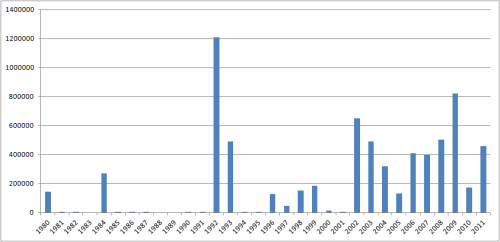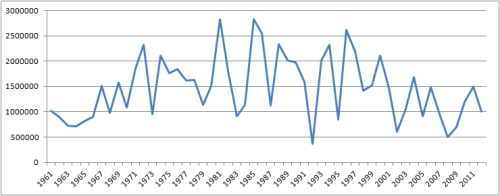Endless repetition often results in such narratives being accepted as fact. I have heard this argument from multiple sources, including those who frankly should know better. It's a nice media sound-bite, and it serves particular interests.
But what's the truth behind these claims? As ever 'myths' of this sort have some element of reality embedded in them. The graph below shows the pattern of maize imports since Independence in 1980. There is no doubt that maize imports have become more regular since 2000. In the coming year, we will likely have another high figure.
Graph 1: Maize imports, 1980-2011 (tonnes)

But the argument that Zimbabwe never had to import food before is simply untrue. The major drought of 1992 resulted in the highest ever import requirements, exceeding even the most dramatic predictions for this year. And there were other occasions too in the period from Independence to the 2000 land reform – in 1993, 1996, 1997, 1998, 1999, and earlier in 1980 and 1984. Each of these was associated with production collapses, due to multiple causes usually precipitated by drought.
If we look at the total production of maize and the pattern of rainfall (an averaged figure for the country as a whole) we see more interesting patterns. Since 1961, production has fluctuated dramatically, with the contribution of small-scale and large-scale production varying over time. The levels of variability have also increased over time, with grain (maize and small grains) production being much more tightly correlated with rainfall in recent years, and highly affected by climatic events. With longer-term climate change impacts likely to result in greater rainfall variability, this is concerning, and suggests the need for more drought proofing policies.
Graph 2: Maize production, 1961-2012 (tonnes)

Graph 3: Maize and small grain production and rainfall, 1980-2012 (thanks to Blessing Butaumocho for this graph)

The import figures are from FAOSTAT, with all the cautions and qualifications that go with that. They are therefore only official, recorded figures, and do not take account of informal cross-border trade. As we found out in Masvingo province during the 2000s, this is significant, involving all sorts of exchanges, with food flowing in often large quantities in both ways to Mozambique and South Africa. The grain production figures too are limited by the sampling approaches used, and are biased towards communal area production. Since 2000 sampling biases have meant that production from the A1 farms has not been accounted for sufficiently, although this is being corrected.
Bearing all these many limitations in mind, what should make of it all? Is the 'basket case' narrative justified? The data show that since Independence there have been three broad phases that have affected the overall food economy. Identifying these helps to focus attention on what needs to be done now, rather than harking back to an assumed golden era past.
In the immediate post-Independence period, there was much emphasis on food production. Government initiatives supported communal area farmers in particular through credit, loans and extension support. This was the much hailed phase of Zimbabwe's 'green revolution'. At the same time, large-scale commercial farmers continued to produce food, often through irrigation, as they had pre-Independence under the UDI sanctions regime.
Towards the end of the 1980s and into the 1990s, especially following ESAP (the economic structural adjustment programme) from 1991, subsidies and other government support for communal area agriculture declined, and the nascent 'green revolution' collapsed. At the same time globally driven market incentives encouraged shifts of the commercial sector away from maize to higher value and often less land intensive production. This included livestock (with a big move of beef production to the Highveld), wildlife and game farming (for eco-tourism and hunting, including in the high rainfall areas), horticulture and floriculture (linked to supermarket value chains) and an expansion of tobacco. All of this meant that less maize was produced, although there was still a core irrigated production, increasingly of feed, that remained important. The impact of these changes on food production levels and methods was severely felt of course in the 1992 drought, but also in other years in the 1990s, resulting in an increasing frequency of imports.
After 2000, things changed again with land reform, and the maize production under irrigation more or less disappeared, with the exception of a few A2 farms being revitalised in recent years. Communal area production remained depressed, and increasing land competition meant that surpluses were rare. Season to season storage was limited as small grains that store well were replaced by maize. It has taken some years for A1 farms to gain momentum due to establishment challenges, but for much of the 2000s, the economic crisis affected production dramatically. After 2009, and the stabilisation of the economy, things improved, but droughts affected production for several years, including the last season. Without irrigation on any significant scale focused on food production, output has become more variable and imports have been necessary.
Thirteen years on, we would expect that the (no longer) 'new farmers' would be established. Most reflections on resettlement identify a decade as the minimum period for establishment and transition, but this assumes sustained support and investment. This has been starkly absent, both from government and donors who have shied away from development interventions in so-called 'contested areas'. The result has been a slower improvement than hoped for.
In our study areas in Masvingo, we see a progressive increase in the proportion of households producing more than their household food needs through the 2000s, with 30-40% regularly selling some surplus maize. However, the rate of growth has tailed off over time, as longer term challenges – of soil fertility and inputs, of infrastructure, of markets and so on – have hit. But overall production and levels of food security in the A1 farms remain significantly higher than in nearby communal areas. Unfortunately, as discussed last week, this dynamic is poorly represented in national figures on food production, as production from new resettlement areas often goes unrecorded, and increasingly such output, especially of maize, is channelled via informal channels, and so is difficult to capture in standard surveys.
Production of maize from the new resettlements is however highly vulnerable to rainfall variation given the lack of irrigation. In addition, price and market incentives will probably continue to see a drift towards contracted crops, such as tobacco and cotton, away from food production, meaning that overall food deficits and import requirements will persist, even if across all commodities aggregate agricultural production and income increases.
Since the 1980s, first large scale commercial farmers and now resettlement farmers have shifted from growing maize to other higher value commodities, for the same perfectly sound reasons. Since the 2000s, food production is even less resilient than it was in the 1990s, due to the lack of last-resort irrigation, either on state or private large-scale farms. The maize surplus era of the 1980s, when both communal and commercial farmers were growing large quantities, backed by government support, has long gone. But this does not mean that Zimbabwe's agricultural sector is a 'basket case'. It has restructured, and is confronted by new problems, requiring new solutions. Dreaming of the 1980s will not help.
What should we conclude? Here are four thoughts to end on:
- Zimbabwe has often imported food, and will continue to do so. This is not a bad thing if the prices are reasonable, and trade is efficient. However in times of regional drought, this is risky, and an emphasis on local production, and strategic reserves, is needed. As argued a decade ago by Thom Jayne and Mandi Rukuni, a simplistic policy approach to national food self-sufficiency does not make sense. Expensive, overflowing grain silos may not be the best indicator of a sound food economy, but instead there is a need for a resilient system that involves managed imports in times of drought combined with improvements in local production.
- Drought proofing such production is needed as a core policy to improve the resilience of the system. This includes improving storage systems, so that people can tide over from one season to the next; encouraging switching to drought resistant crops such as small grains, and continuing to invest in drought tolerant maize varieties; improving irrigation systems, including very small scale water harvesting systems, as well as 'schemes'; and focusing on livestock as an important asset for exchange in times of drought.
- Price and market incentives need to ensure that it pays to grow food crops, and there is a balance between maize and tobacco production overall. This includes extending contracting systems to food crops, and improving input supply and other support to ensure that food crops are profitable. Efficient grain markets are essential to avoid distortions.
- Investment should be focused on areas where surplus production is possible, and this must include first and foremost the A1 resettlement areas. Ensuring effective market links so that such surpluses can be exchanged locally and regionally will be important. This will mean investment in roads, transport and so on, and avoid any restrictions on movement of grain and agricultural commodities.
